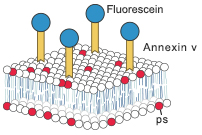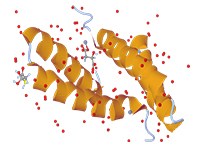Cell Related Detection Kit
Elabscience® provides simple and sensitive solutions for detecting cell apoptosis, activity and vitality. These kits are based on flow cytometry, microscopy or microporous plate which can be used to detect cell apoptosis, proliferation and toxicity or cell cycle.
Cell Apoptosis Assay
Cell death is the result of cell senescence and the termination of cell life phenomenon. Apoptosis is a complex and active death, involving the activation, expression and regulation of a series of genes. Apoptotic detection methods are mainly based on the following analysis.
-
1. Phosphatidylserine Extemalization
It occurs at early apoptosis and runs through the whole cell apoptosis. Annexin V can bind to valgus phosphatidylserine under the action of Ca2+.
Annexin V with DNA dyes such as PI and 7-AAD can distinguish living cells, early apoptotic cells, late apoptotic cells and dead cells.
Click here to see more about Annexin V Detection Kits
-
2. Decrease of Mitochondrial Transmembrane Potential
The decrease of mitochondrial membrane potential is considered to be the earliest event in process of cell apoptosis. JC-1 dye exhibits different fluorescence emission due to different mitochondrial membrane potential. Cell apoptosis can be detected by detecting the change of cell membrane potential by JC-1 emission light.
Click here to check the Mitochondrial Transmembrane Potential Detection Kit(JC-1)
-
3. TUNEL Assay
When cells undergo apoptosis, a large number of viscous 3'-OH are produced by breakage of chromosomal DNA. Under the action of deoxyribonucleotide terminal transferase (TdT), the deoxyribonucleotides and derivatives of fluorescein, peroxidase, alkaline phosphatase or biotin can be labeled to the 3'-terminal of DNA, so that apoptotic cells can be detected.
Click here to see more about TUNEL Assay
-
4. Caspase Assay
Caspase family plays a very important role in the process of cell apoptosis. Caspase-3 is a key executive molecule, which plays a role in many pathways of apoptotic signal transduction. Caspase exists in the cytoplasm in the form of zymogen and in the early stage of apoptosis, the caspase is activated which eventually leads to apoptosis.
Click here to see more about Caspase Assay
Cell Proliferation and Toxicity Detection
At present, MTT colorimetry and CCK8 kit are the main methods to detect the cell proliferation. MTT Assay kit can be widely used in cell proliferation and cytotoxicity detection, while Cell Counting Kit 8 (WST-8 / CCK8) is a highly sensitive, non-radioactive colorimetric method for detecting the number of living cells in cell proliferation or toxicity test, which can replace the traditional MTT method.
Click here to see more about Cell Proliferation and Toxicity Detection Kits
Cell Cycle Assay
Cell cycle refers to the whole process from the end of one mitosis to the end of the next. DNA cycle detection can be used to reflect the status of each phase of the cell cycle, which is called cell proliferation. Using the characteristics of DNA binding with fluorescent dyes (such as propidium iodide PI), the amount of fluorescent dyes binding to DNA at different stages is different, which makes the fluorescence intensity detected by flow cytometry different.
Click here to see the Cell Cycle Assay








